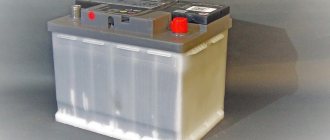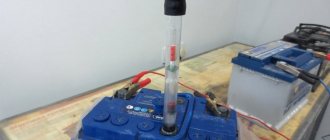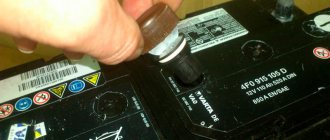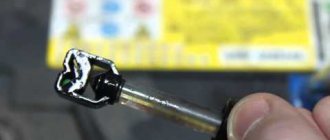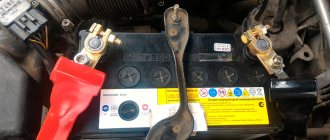The industry produces conventional and dry-charged car batteries; batteries of the second type are supplied from the factory empty, unfilled with sulfuric acid solution. But in any case, you need to pour electrolyte into the battery; without it, the battery will not work.
- 1 Electrolyte volume in batteries 55 and 60 A/h
- 2 How much electrolyte is poured into batteries 75, 90 and 190 A/h
- 3 Rules for filling electrolyte
- 4 Importance of density values
- 5 Dry-charged batteries
- 6 If the density is below normal
Since batteries come in different capacities, they require different amounts of sulfur solution. In this article we will look at how much electrolyte should be poured into batteries of large and small sizes, and how to properly use and dilute a sulfuric acid solution.
Weight of battery 60 with electrolyte
The standard 60 A/h 12 volt battery consists of a case and 6 cans. Which contain:
- Records.
- Electrolyte solution.
- Separators.
- The main part of it lies in the plates and in an acid solution, which is much heavier than water.
- Also, the battery base is made of strong special plastic, which adds additional weight to the product.
- The weight of a battery acid battery generally ranges from 13-16 kg.
Importance of Density Values
The main parameter that determines the properties of the electrolyte is density. The parts of water and sulfuric acid in the solution must be contained in a certain proportion: an electrolyte that is too dense contributes to the rapid failure of the plates, and the sulfation process is activated.
If the density is less than the established norm, the battery may freeze in the cold winter; the reduced concentration of the solution contributes to the rapid discharge of the battery. To increase the density, the battery is charged; in winter, the electrolyte concentration should always be higher, and lower in warm times, especially in the heat. The density in the battery is measured with a hydrometer, the values are within the range:
- for the summer season - 1.23-1.25 g/cm?;
- in winter - 1.26-1.29 g/cm?.
For machines operated in the Far North, the density can reach higher values, but all these indicators are relative, and they can only be taken as a general recommendation. If you have no idea what concentration the solution in the battery should be, it is better to consult a specialist; there is conflicting information on the Internet and other media.
Battery sizes and types of terminals
To install a battery under the hood of your car, you must be familiar with the exact size chart of all types of suitable batteries, as well as the types of their clamps. It is advisable to familiarize yourself with the parameters not only of length and width, but also to find out the required height. So that the battery can fit exactly in its place.
A standard 60 Ah battery comes in three versions:
| Type of battery | Width, cm | Length, cm | Height, cm |
| Standardized | 17.5 | 24.2 | 19.0 |
| Short | 17.5 | 24.2 | 17.5 |
| Asiatic | 17.3 | 23.2 | 22.5 |
It is also worth considering the difference in terminal types to accurately select your battery. The following types of clamps can be installed by the manufacturer on a 60 Ah battery:
- Standardized. European and Russian batteries are most often equipped with such terminals. The diameter of the positive clamp is 19.5 mm, the negative clamp is 17.9 mm.
- Asian. Terminals of this type predominate on Asian cars. The shape of these clips protrudes upward from the outside of the battery. Here the positive clamp is 12.7 mm, and the negative clamp is 11.1 mm.
- American. These clamps are found on American cars made in the USA. They are standardly located on the side of the battery and have an internal thread. Such batteries are not compatible with European or Asian type clamps.
All batteries can be produced with direct and reverse polarity.
Batteries 55, 60, 75, 90, 190 A/h - distinctive features
Standard 55 and 60 batteries are common in conventional passenger car designs. But “seventy-five” and “nineties” batteries can be found on powerful SUVs. Or VIP-class cars, where there are a large number of additional installations, including electrical packages, climate and cruise controls, headlight cleaners, etc. In this case, all devices require a large amount of energy, which the corresponding battery must contain.
Large capacity batteries have a significant weight: the 75th is about 20 kg, and the 90th is approximately 25 kg. As for the 190 battery, it is not installed on passenger cars, but is used for buses, trucks and special equipment. The weight of such a huge battery can reach up to 42 kg. There are also other types of batteries available: 110, 140 and others. But these types are isolated and quite rare.
How much electrolyte is in the battery 55, 60, 190 A/h
The battery is standardly selected based on the engine size of the car. The larger the battery capacity, the more electrolyte the battery will hold. After all, the internal area for filling in such a battery is larger. Let's consider how much electrolyte is needed for different types of batteries.
Approximate amount of electrolyte for batteries of different capacities
| Battery capacity, Ah | Required amount of electrolyte, l. |
| 55 | 2,5 |
| 60 | 2,7-3,0 |
| 65 | 3,5 |
| 75 | 3,7-4,0 |
| 90 | 4,4-4,8 |
| 190 | 10,0 |
The amount of electrolyte will also depend on the model and manufacturer of the battery. When pouring electrolyte, you must comply with the parameters specified by the manufacturer. You also need to ensure that the electrolyte covers the plates approximately 1 cm higher, but not more than 1.5 cm.
Dependence of volume and current strength
It is clear that the volume of 45Am/h will be much less than that of the 190Am/h option. If you dig into the physics, a powerful battery requires more lead (which is placed in a more bulky case), which is why the dimensions of the 190 version will be almost 4 - 5 times larger than, say, the same 45. And where there is more of this metal, more electrolyte is needed to effectively accumulate voltage.
However, if you think about the question - how much do you need to buy in order to guess for all options (take it as if with a reserve), the answer suggests itself. After all, the maximum canister, which is sold in only five liters, is therefore suitable for almost all models. In order not to be unfounded, I want to analyze the most popular “Amperages”.
Let me make a reservation right away: there are slight differences depending on the manufacturer, but they vary by insignificant grams.
Correct operation of batteries and filling of electrolyte
Modern batteries are usually divided into 2 types: serviced and maintenance-free. The second type is the most convenient for the average user; the electrolyte is already present in it. And the car owner uses it in the form provided by the manufacturer.
If you have a serviceable battery into which you need to add electrolyte yourself, you must carefully follow the basic rules. To ensure that your battery lasts the full time allotted for it.
In what volumes is electrolyte sold?
Now it’s not such a big problem to buy this liquid, you just need to sit down and go to a specialized store that sells batteries; it’s unlikely to be available in ordinary spare parts.
Basically it is sold only in two containers, these are 1 liter (bottle) and 5 liters (canister). If you were repairing, say, eliminating a short circuit, you only need to fill one jar, then 1 liter will be enough for you, as they say “for the eyes.” The cost ranges from 50 rubles for a liter bottle and up to 200 for five liters.
But if for some reason you need to change the entire volume, then it all depends on the size of your battery and its power.
Failure to maintain correct electrolyte levels
Both high and low levels of electrolyte solution in the battery pose a safety risk.
- Danger if the level is too high: excess electrolyte will escape through the battery cells, which can cause an explosion or excessive amounts of harmful gases.
- Danger if the level is too low: this chemical process causes sulfation of the plates in the battery banks. Also, undesirable low-level impacts include a drop in the battery capacity installed by the manufacturer and, as a result, poor battery performance.
Determination of electrolytic fluid in a battery
There are two types of energy sources commonly used in the automotive industry today:
- Maintenance-free devices are enclosed in a sealed housing that completely prevents access from the outside. They, as a rule, exhaust their resource and must be replaced. You cannot restore their functionality on your own. The only thing the owner of such a battery can do is charge it as needed.
- Maintained - require constant attention and monitoring. It is necessary to regularly monitor the level of the electrolyte solution, as well as its density and the condition of the plates.
How to find out the electrolyte level
Electrolytic liquid can change its volume as it is stored and used. How can you check the electrolyte level in a battery? There are several options, each of which can be used in a specific situation:
- According to special marks applied to the body. Some energy sources have two horizontal lines parallel to each other on the outer surface of the housing in its upper part. The bottom one is marked “min” - shows the minimum possible level of the electrolyte solution. The top one has the inscription “max” - the maximum permissible limit of the liquid medium.
- By visual inspection. It allows you to determine the approximate amount of liquid content. In the absence of tags and other available means, it is enough to simply unscrew the plugs on the top cover of the case, while installing the device on a flat horizontal surface. Looking inside, especially if there is good lighting, you can understand by the following criteria whether the solution is enough or not:
- the plates are completely hidden by the liquid medium, there are no leaks on the outside of the case - the level is normal;
- the electrodes are visible (they are level or above the surface of the liquid) – topping up is required.
- By performing simple measurements. The electrolyte level in the battery can be checked using:
- Hydrometer device. It will allow you to find out the density of the liquid in each jar, which will make it possible to draw a conclusion about its quantity. We lower it into each hole one by one, draw up the solution using a bulb and look at the readings. If the value is higher than normal, then the level is insufficient.
- Available means: a transparent juice tube or the same body of a ballpoint pen. We lower the tube into the hole in place of the unscrewed cap until it rests against the top edge of the jar. We pinch the end remaining on the surface with a finger, thus blocking the flow of air into it. Holding your finger, remove the tube and measure the height of the column of liquid trapped inside it. At a normal electrolyte level, its value should be in the range from 11 to 15 mm.
Low battery electrolyte level
How can you tell if your battery has low electrolyte levels? This is very eloquently evidenced by:
- significant increase in density;
- the appearance of plates above the surface of the liquid medium.
There may be several reasons for this:
- Evaporation of distilled water is the most common factor in volume reduction in the summer. As is known, too high outdoor temperatures provoke evaporation processes. And when using the battery during this period, it is very hot under the hood.
- Liquid boiling over due to a malfunction of the temperature relay-regulator.
- As a result of battery discharge, some of the acid is consumed for electrochemical reactions.
A decrease in the electrolyte level below normal in the battery leads to very serious consequences:
- firstly, a solution of increased concentration promotes accelerated destruction of the plate material;
- secondly, that part of the electrode surface that is located above the liquid boundary undergoes sulfation.
In both cases, the outcome is the same: rapid loss of capacity and premature failure of the energy source. This means it will need to be replaced. Where is the guarantee that the new battery will not lose its functionality just as quickly?
Option one is to learn how to properly operate and maintain the battery, and first of all, maintain the liquid component at normal levels.
What should be the electrolyte level in the battery? The norm is when the electrolyte solution is 1–1.5 centimeters above the electrode plates, completely covering them when the car is moving. Moreover, the electrolyte level must be the same in each jar - this is very important for reliable battery operation.
Charging safety
The most dangerous operation when charging a battery is disconnecting it from the charger. In some cases, this may cause an explosion. During charging, reactions occur to release hydrogen from the electrolyte. However, large professional chargers are more susceptible to such reactions.
Car owners or craftsmen who deal with chargers should not approach it with cigarettes or other types of fire. It is possible to disconnect the clamps only after completely disconnecting the charger from the power supply.
If the density is below normal
When the density of the electrolyte in any of the cans is below normal, the battery will not work normally and will not be able to start the engine. There is an opinion that you should pour the liquid out of the battery and fill in a new sulfur solution, but this is not recommended - when the battery is turned over, particles of lead sediment from the bottom can short-circuit the plates, and then the battery will fail. There are several proven ways to restore density:
- charging the battery using a charger with a small current;
- electrolyte replacement - using a bulb, pump out some of the old liquid from the jar (which is located on top of the plates), add a fresh solution, the concentration may be even higher than normal;
- adding pure sulfuric acid, but this method is not popular.
If the density is still lost and it is impossible to restore it, there is no point in “revitalizing” the battery; it must be replaced.
What amount of current is needed to charge a 60 A/h battery?
The current strength is determined by the battery capacity and is calculated at the rate of 10% of the capacity value. If the battery has a capacity of 60, then the current value is calculated up to 6 amperes. At a voltage of 14.4V, such a battery charges in approximately 10 hours.
Modern chargers include an automatic current control system. Using these functionalities is the safest and most convenient. Since the car owner does not need to independently configure these parameters and control them.
For which cars is a 60 A/h battery suitable?
Standard 60 Ah 12 volt batteries are suitable for passenger cars with engines up to 2 liters. It is believed that domestic cars, in which a 55 Ah battery is installed by the manufacturer, can be converted to a 60 Ah battery without negative consequences.
At the same time, the dimensions of the batteries of these capacities must be identical and the location of the clamps must match so that one battery can easily replace another. It is believed that changing 55 AH to 60 AH will strengthen the vehicle’s operational position.
If the car has a Start-Stop system, then the battery is selected with EFB, GEL or AGM technology. Such batteries can withstand deep discharges, but to recharge them you will need specialized charging functionality.
Reviews
Nikolai. Murmansk. I purchased a new Bosch s4 silver battery with a capacity of 60 A/h for my fret. The battery turns the starter perfectly in any weather, and during the polar night it provides good visibility on the road, even at low engine speeds.
Grigory. Stavropol. A very good battery for a car is Titan 6 st 60 A/h. You often have to drive your Mazda at night, so increased battery capacity is as necessary as air.
Alexander. Kerch. I have been buying Forse batteries for my UAZ for over 10 years now. Products of excellent quality, including high-capacity models.
Before talking about the volume of electrolyte in the battery, I highly recommend an article on what this liquid consists of. Today's information will be useful to almost everyone, especially those who restore batteries, say, after a bank shorts, and do not know how much to buy, because the old one was drained and is really no longer suitable for use. It often happens - this liquid simply evaporates, generally to zero, of course, I have rarely seen this in car batteries, but for example, in uninterruptible power supply installations for servers - computers, it can happen quite often...
CONTENTS OF THE ARTICLE
Previously, during Soviet times, the electrolyte was sold separately. That is, there were so-called “dry” batteries into which you yourself had to pour this liquid and charge it correctly. However, now technology and production are moving forward, the factories are fully filled and charged, and then they are put into mass consumption. Now the batteries are sealed and non-separable!
Choosing the right 60 Ah battery
To ensure long battery life, proper care is required. It needs to be charged correctly, monitor the electrolyte level, and clean it of plaque and dirt. At low temperatures in winter, it is advisable to bring the battery home at night.
And some drivers install a special thermal case with heating plates to better protect the battery. When changing a battery, it is always better to choose trusted brands.
The most famous of the domestic brands are: Magnum, AutoFan, Tornado, Akom, Zver. Foreign models that inspire confidence are indicated by car enthusiasts in this order: Moratti, Varta, Uno, Fireball, Westa.
This list includes models that have all the modern advantages for passenger cars with an engine capacity of up to 2 liters.
What affects battery life
Using the battery during periods of extreme temperature fluctuations may shorten its service life. In addition to mechanical damage to which the battery may be subject.
In winter, pieces of ice in the form of crystals can accumulate on it, and the electrolyte in the battery banks can also freeze. Therefore, it is important not to let the battery overcool.
If you live or use your car in an area with harsh winters, you can simply take the battery home at night. When the air temperature drops extremely low, so that the battery warms up evenly.
Some car enthusiasts use a thermal case with heating plates for these purposes. Otherwise, cracks may form on the battery due to temperature changes, so it is very important not to let it freeze too much.
If you were unable to protect your battery, and a crack still formed, then such a battery must be immediately disconnected from the vehicle systems and disposed of, because its further use is prohibited.
However, if the battery case itself is slightly swollen, but the seal is maintained, this battery can still be used in a car.
You can check the suitability of the battery in the following ways:
- First you need to check the level and density of the electrolyte in the battery. To do this, unscrew the cans and check the level inside the cans. Next, the battery should be set to charge for 24 hours with a current of 1 A. In this case, it is worth measuring the density of the electrolyte during this recharging. As the density increases, a conclusion is made about the suitability of the battery.
- For a more detailed check, you need to drain the old electrolyte, completely rinse the jars with distillate, then prepare a new electrolyte solution in the correct way, pour it in and leave for a while. Next, recharge in quiet mode with a current of 0.5 - 1 A. If the battery is working, then the density should increase when measured after a couple of hours.
Dry charged batteries
Dry-charged batteries are the same as conventional batteries with lead plates, but differ in the absence of electrolyte. First, such batteries are charged at the factory, then the electrolyte is poured out of them. This method allows you to store an energy storage device without loss of properties for several years, while the jars with the plates are reliably sealed - covered with a special packaging film.
Before use, electrolyte is poured into the battery, and the density must be checked. When the concentration of the solution is weak, charging is carried out, and only after that the battery is ready for use. If the battery is recently manufactured (no more than one year has passed since production), it does not need to be charged; it is only important to fill it with electrolyte of the required density. It is unacceptable to operate an empty battery, and even if you try, it will not work - a discharged and dry battery does not have any power, it will not be able to make the engine starter rotate.

